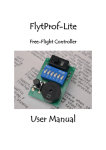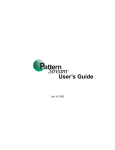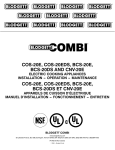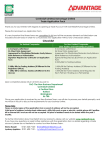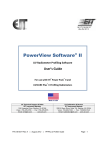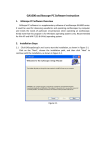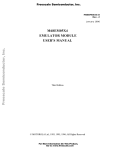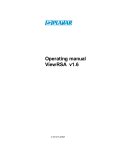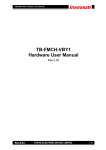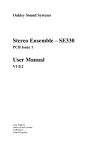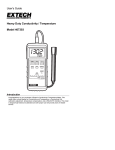Download FlytProf-Four User Manual
Transcript
FlytProf-Four Free-Flight Controller User Manual The Model Electronics Company Electronics made for Modellers Table of Contents Heading Page Table of Contents IFC Introduction 1 Flight Mode 2 Flight Phase Timing 2 In-Flight Safety Features 3 4 Programming Mode Phase 4 AUX Output Setting 5 Default Settings 5 The Flight Control System 6 Power Supply 6 Electronic Speed Controller 6 Auxiliary Servo 6 Connecting Up 7 Power-Up Sequence 7 Acknowledgement 7 Wiring Diagram 8 PCB Component Layout and Mechanical Details 8 Programming Examples 9 Standard Flight – taking off from the ground 9 Double ‘Climb and Glide’ Flight – hand launched 9 Timed De-Thermaliser Function – hand launched 10 Removing a Flight Phase 10 Blank Programming Tables 11 Specification Table 12 Phase Timing and Signal Table 12 Default Settings Table 12 DIP Switch Settings Table IBC FlytProf-Four Free Flight Controller - User Manual Issue 1.0 26-01-08 The information contained within this manual is believed to be correct. However no responsibility is assumed for its use. IFC The Model Electronics Company Electronics made for Modellers Introduction FlytProf-Four is a small, self-contained and simple-to-operate microprocessor based unit designed to provide electric free-flight modellers with a means of controlling an aircraft's flight profile. It operates as the central, controlling element of a Flight Control System by stepping through a pre-programmed sequence of timed Phases and, for each Phase, provides two standard R/C servo drive outputs. The first of these is intended to drive an external motor speed controller [ESC] to provide power control and the other, usually connected to a servo, provides an auxiliary [AUX] function and is connected to the PCB terminal marked ‘DTS’. FlytProf-Four enables complex flight profiles to be implemented by providing 4 fully independent, user-programmable Flight Phases, which may be considered to provide the Rise-off-Ground, Climb-Out, Cruise and Glide sections of a typical flight. The programmable Flight Phases are bracketed by two fixed Phases; the Launch Phase, which runs the motor up to the speed set in the R.O.G. Phase while still on the ground and the Landing Phase, in which the motor is shut down to bring the model down. Each of the 4 programmable Flight Phases has programmable ESC drive, AUX drive and Duration parameters – see the Phase Timing and Signal Table section. Setting of the three programmable parameters is achieved by means of an onboard 6-way DIP switch and timed push-button presses and, once entered, the flight profile program is stored in non-volatile memory [NVM] ready for immediate use on the flying field. There is no practical limit to the number of times the parameters may be reprogrammed. FlytProf-Four has two operating modes, known as Flight and Programming. Selection of the operating mode and control of the unit in each mode is performed by the board mounted push-button with acoustic feedback provided by the on-board buzzer. FlytProf-Four may be identified within the FlytProf family by the blue pushbutton. FlytProf-Four Free Flight Controller - User Manual Issue 1.0 26-01-08 The information contained within this manual is believed to be correct. However no responsibility is assumed for its use. Page 1 The Model Electronics Company Electronics made for Modellers Flight Mode Powering-up FlytProf-Four without pressing the push-button causes it to enter Flight Mode in a Pre-Launch state. In this condition the ESC drive is set to 1.00ms – in order to 'arm' the speed controller – and the AUX drive is set to its central position of 1.50ms. The buzzer emits a continuous sound indicating that the unit is waiting for the push-button to be pressed. Momentarily pressing the push-button causes FlytProf-Four to enter the Launch Phase in which it sets the AUX output and ramps up the motor speed to the values programmed in for the first Flight Phase. Once the motor has reached its programmed speed FlytProf-Four automatically enters Flight Phase 1 (the R.O.G. Phase) and begins timing its Duration. Short 'ticks' are emitted by the buzzer at 1-second intervals confirming that the timing system is operating correctly. On expiry of the timer, FlytProf-Four enters the next Flight Phase in which the ESC and AUX drives are set to the corresponding user-programmed values and the duration timer is restarted with the next programmed value. This process continues until each of the 4 Flight Phases has been executed and, at the end of the Glide Phase, the unit enters the Landing Phase shutting down the motor to bring the model down. On recovery of the model the buzzer will be heard emitting 1-second ‘ticks’ indicating that the flight sequence completed normally. To accommodate flights that end prior to the programmed duration pressing the push-button until a continuous sound is heard, and then releasing it, at any time after the completion of Flight Phase 1 cancels the current flight timing sequence and places FlytProf-Four back into its Pre-Launch condition ready to enter a new Launch Phase. This permits a new sequence to be started without the need to cycle the power. Flight Phase Timing To increase the unit’s flexibility, the Duration of each Flight Phase is programmable with two resolutions. Settings in the first section of the DIP Switch Settings Table offer timings of between 1 and 15 seconds in 1-second steps FlytProf-Four Free Flight Controller - User Manual Issue 1.0 26-01-08 The information contained within this manual is believed to be correct. However no responsibility is assumed for its use. Page 2 The Model Electronics Company Electronics made for Modellers while the remaining 3 sections permit Flight Phase Duration values from 20 seconds to 255 seconds (4.25 minutes) in 5-second increments to be programmed. NOTE: contrary to typical mechanical timers in which all timers are started at launch, FlytProf-Four starts timing each Flight Phase at the expiry of the previous Phase. Thus, for the normal application, a setting of 10 seconds for each Phase results in a flight lasting for 40 seconds. In-Flight Safety Features FlytProf-Four has two safety features built in to its program. The first of these is a battery voltage detection system which, in the event of a significant dip in supply voltage during a flight, causes the unit to re-enter its Pre-Launch condition shutting down the motor . On recovering the model the activation of this mechanism may be determined by a continuous tone being emitted from the buzzer rather than the normal 1second 'ticks'. The second safety feature detects a stuck pushbutton. At the end of the first Flight Phase – R.O.G. – the pushbutton is checked and if it is found to be 'pressed' the unit immediately enters a Safety Phase shutting down the motor and setting the AUX output to its central position to bring the model down. The buzzer issues a buzzing sound to indicate that this mechanism has been triggered and the power must be switched off to cancel this condition. FlytProf-Four Free Flight Controller - User Manual Issue 1.0 26-01-08 The information contained within this manual is believed to be correct. However no responsibility is assumed for its use. Page 3 The Model Electronics Company Electronics made for Modellers Programming Mode Holding the push-button pressed while powering-up causes FlytProf-Four to enter Programming Mode, which it confirms by emitting 3 short 'beeps' from the buzzer. Releasing the push-button causes the buzzer to emit a continuous sound indicating that the unit is waiting for a button press. It is from this 'idle' state that the user first selects which of the 4 Flight Phases is to be programmed. The Flight Phase selection sequence is started by pressing and holding the pushbutton. The buzzer then starts emitting a sequence of four 1-second long 'silences' followed by 1-second long 'bursts-of-bips' – indicating the four possible Phase selections. Releasing the button during any one of the four 1-second 'burst-of-bips' determines which of the four Phases is to be programmed in the following Phase Parameter programming section. The Flight Phase selection is confirmed by the buzzer emitting a corresponding number of short ‘bips‘. NOTE: the Flight Phase selection sequence is cyclic and so, if the intended phase selection slot is missed, then simply keeping the push-button pressed until the appropriate slot in the next cycle will make the selection correctly. The start of a new selection cycle is indicated by an extended period of silence. Once the Flight Phase has been selected FlytProf-Four automatically enters the next section of the programming process permitting the corresponding three Phase Parameters to be programmed. It enters an ‘idle’ state, which is indicated by the buzzer emitting a continuous tone, and it is in this ‘idle’ state that the DIP switch may be set to determine the value of the parameter to be programmed – see the DIP Switch Settings Table. Once the DIP switch has been set, the Phase Parameter programming sequence is started by pressing and holding the push-button. This immediately silences the buzzer, which then starts emitting a sequence of three 1-second long 'silences' followed by 1-second long 'beeps' – indicating the three Phase Parameter programming slots. Releasing the button during one of the three 1-second 'beeps' determines which of the parameters is to be programmed:1. Motor Speed Pulse Width 2. Auxiliary Output Pulse Width 3. Flight Phase Duration in ms in ms in seconds – see DIP Switch Settings table FlytProf-Four Free Flight Controller - User Manual Issue 1.0 26-01-08 The information contained within this manual is believed to be correct. However no responsibility is assumed for its use. Page 4 The Model Electronics Company Electronics made for Modellers Confirmation of programming is indicated by the emission of two short 'beeps' and FlytProf-Four then returns to its idle state, with the buzzer sounding continuously, waiting for a push-button press to initiate programming of the next Phase Parameter. Any, or all, of the Phase Parameters may be programmed as many times as required during each programming session. NOTE: the Phase Parameter programming sequence is cyclic and so, if the intended programming slot is missed, then simply keeping the push-button pressed until the appropriate slot in the next cycle will program the unit correctly. The start of a new Phase Parameter programming cycle is indicated by an extended period of silence. To exit Programming Mode switch off the power when FlytProf-Four is in its idle state and emitting a continuous sound. To program the Phase Parameters for another Flight Phase, re-enter Programming Mode by powering-up the unit while depressing the push-button. Phase 4 AUX Output Setting During the fixed Landing Phase FlytProf-Four automatically sets the ESC output to 1.00ms to shut the motor down and, additionally, it maintains the user’s programmed setting for the AUX output from Phase 4. It is, therefore, important to consider this aspect when deciding on the value to be programmed for the AUX output during Phase 4. Default Settings FlytProf-Four is shipped with a set of default Parameter values as indicated by the Default Settings Table. These provide a range of ESC and AUX output settings and short Flight Phase durations and are suitable for initial land-based testing. They may be restored separately for each of the four Flight Phases, as a set of three Parameters, at any time by first selecting the appropriate Flight Phase and setting the DIP switch to the all-zeros code and programming any one of the 3 Phase Parameters. Confirmation that the default values for the selected Flight Phase have been successfully restored is indicated by the buzzer emitting 4 short ‘beeps’ rather than the usual two. FlytProf-Four Free Flight Controller - User Manual Issue 1.0 26-01-08 The information contained within this manual is believed to be correct. However no responsibility is assumed for its use. Page 5 The Model Electronics Company Electronics made for Modellers The Flight Control System Power Supply The Flight Control System is powered by the Battery Eliminator Circuit [BEC] within the ESC – see the Specification Table section. Using this method the flightpack voltage is reduced within the ESC to about 5V and is typically provided on the central pin of its servo-lead connector. The FlytProf-Four PCB is wired to route this supply via the Power Switch to the on-board electronics and to the central pin of the AUX [DTS] connector. Thus the flight-pack provides power for the entire Flight Control System saving the weight and bulk of a separate pack. NOTE: in order to prevent possible erratic operation in flight, it is important to verify, by means of ground-based testing, that the BEC can provide enough current to drive the AUX Servo under worst case battery and load conditions. Electronic Speed Controller The choice of ESC is not critical and may be selected from the available range based on the preferred motor type, brushless or otherwise, and power rating. It must be capable of accepting the standard R/C servo control signal of a 20ms frame containing a 1-2ms positive-going pulse and interpreting a pulse width of about 1.00ms as zero power and a pulse width of about 2.00ms as full power. Additionally, it must be verified that its on-board BEC can provide enough current to drive the chosen AUX Servo and that it will operate successfully from the desired flight-pack voltage – some ESCs place a limit on the maximum number of flight-pack cells if their on-board BEC is to be used. Auxiliary Servo The selection of AUX Servo is also not critical and should be based on the weight and power requirements of the model. During a typical flight the AUX Servo is idle for most of the time, operating for only a second or so at every Flight Phase change, and thus its overall power requirements are very low. Selecting a low-current servo will reduce the risk of control system failure due to battery voltage droop. FlytProf-Four Free Flight Controller - User Manual Issue 1.0 26-01-08 The information contained within this manual is believed to be correct. However no responsibility is assumed for its use. Page 6 The Model Electronics Company Electronics made for Modellers Connecting Up Two non-polarised, 3-pin male connectors compatible with standard servo leads are fitted to the rear face of the PCB. They are identified by the acronyms ‘ESC’ and ‘DTS’ and are intended for connection to the Electronic Speed Controller and Auxiliary Servo respectively. Connection orientation is indicated on the PCB by means of an irregular outline corresponding to the shape of a typical servo lead plug and the pin assignments of each of these 3-pin connectors conforms to the standard "0V : 5V : Signal" adopted by Futaba, JR, Hitec etc. – see PCB Component Layout. It is recommended that a device for isolating the battery is included in the wiring harness, as shown on the Wiring Diagram, and using a suitably rated two-part connector will also provide a convenient connection point for recharging the flight-pack. Power-Up Sequence Before making the battery connection ensure that FlytProf-Four’s Power Switch is in the Off position. Once the battery is connected the Flight Control System may be powered-up by moving the Power Switch to the On position. Follow the reverse procedure to power the system down. Acknowledgement Thanks are due to Ian Middlemiss of Peterborough Model Flying Club for providing the original idea for the FlytProf free-flight controller range and also for his considerable efforts and guidance during the development and testing of this product. FlytProf-Four Free Flight Controller - User Manual Issue 1.0 26-01-08 The information contained within this manual is believed to be correct. However no responsibility is assumed for its use. Page 7 The Model Electronics Company Electronics made for Modellers Wiring Diagram Motor + - ESC + - Battery Isolation ESC DTS FPF Flight Pack Servo PCB Component Layout and Mechanical Details To AUX Power Switch OFF ON 24.13 (0.950) To ESC 20.95 (0.825) 0V - Black 5V - Red SIG - Yellow (White) 0V 5V SIG 0 PushButton Buzzer NOTE ESC and AUX [DTS] Connections are on the rear of the PCB 29.21 (1.150) DIP Switch 32.38 (1.275) 1 4 off Holes 1.10 (0.043) Dimensions in mm (in) FlytProf-Four Free Flight Controller - User Manual Issue 1.0 26-01-08 The information contained within this manual is believed to be correct. However no responsibility is assumed for its use. Page 8 The Model Electronics Company Electronics made for Modellers Programming Examples To aid the understanding of the Programming process this section provides a few ‘worked examples’ of Flight Profiles. For each example a textual description is given followed by a table detailing the Parameter settings for each Flight Phase. Standard Flight – taking off from the ground This example describes a typical R.O.G., Climb, Cruise, Glide Flight Profile. The AUX output is connected to the rudder servo and is used to both counteract motor torque during climb and also to set the model into a turn during Cruise and Glide to bring it home. For R.O.G. a high power setting is used for a few seconds, with corresponding right rudder to counteract motor torque. This is followed by a more gentle setting for a longer Climb phase and in the Cruise phase the motor power is reduced further and the rudder set slightly left to induce the turn. The Glide phase reduces the motor power still further and sets the rudder to a suitable position for Landing. Phase 1 – R.O.G. Phase 2 – Climb Phase 3 – Cruise Parameter Value DIP Sw. Value DIP Sw. Value DIP Sw. Value DIP Sw. ESC Drive 1.70 ms 101101 1.50 ms 000001 1.40 ms 100110 1.20 ms 110100 AUX Drive 1.70 ms 101101 1.60 ms 011001 1.40 ms 100110 1.40 ms 100110 5 secs 101000 10 secs 010100 15 secs 111100 20 secs 000010 Duration Phase 4 – Glide Double ‘Climb and Glide’ Flight – hand launched This example describes a hand-launched flight with two separate “Climb / Glide” sections. Phase 1 is re-assigned to provide the initial Climb and Phase 2 provides the first of the two Glide phases. Phases 3 and 4 are set to duplicate this. The intended flight pattern would be a 180 degree climb followed by a gradual lowpower circling descent. A second, longer circular climb would be followed by a final circling descent into land. Phase 1 – Climb 1 Phase 2 – Glide 1 Phase 3 – Climb 2 Phase 4 – Glide 2 Parameter Value DIP Sw. Value DIP Sw. Value DIP Sw. Value DIP Sw. ESC Drive 1.55 ms 110001 1.35 ms 011010 1.55 ms 110001 1.10 ms 101000 AUX Drive 1.60 ms 011001 1.40 ms 100110 1.60 ms 011001 1.40 ms 100110 Duration 10 secs 010100 10 secs 010100 15 secs 111100 20 secs 000010 FlytProf-Four Free Flight Controller - User Manual Issue 1.0 26-01-08 The information contained within this manual is believed to be correct. However no responsibility is assumed for its use. Page 9 The Model Electronics Company Electronics made for Modellers Timed De-Thermaliser Function – hand launched To avoid the risk of model fly-away the AUX output may be used to provide a de-thermaliser function in conjunction with a release pin arrangement. Circling trim must be provided by a manual trim-tab in this example. A high motor power setting is used for the Climb phase, followed by a reduced setting for the Cruise phase prior to shutting the motor down for an extended Glide phase. During all these phases the AUX servo is set to its initial, central position holding the release pin in place and at Phase 4 the release pin is pulled activating the DT mechanism. On recovering the model, the release pin may be re-inserted when FlytProf-Four is in its Pre-Launch condition with the AUX servo in its central position. Phase 1 – Climb Phase 2 – Cruise Phase 3 – Glide Phase 4 – DT Parameter Value DIP Sw. Value DIP Sw. Value DIP Sw. Value DIP Sw. ESC Drive 1.60 ms 011001 1.40 ms 100110 1.00 ms 100000 1.00 ms 100000 AUX Drive 1.50 ms 000001 1.50 ms 000001 1.50 ms 000001 2.00 ms 111111 Duration 10 secs 010100 10 secs 010100 30 secs 010010 3 secs 110000 Removing a Flight Phase There may be occasions when all 4 Flight Phases are not required and this may be achieved by programming the unwanted Phases with minimum values for ESC Drive and Duration. This shuts down the motor and produces a Flight Phase that lasts for only 1 second – effectively removing it from the Flight Profile. The choice of Phase to be removed is not critical but it is important to remember the following points:1. If a removed Phase is to be placed between two used Phases then ensure that the AUX output drive is set appropriately during the removed Phase. 2. If the removed Phase is to be Phase 4, ensure that its AUX output drive is set to a value appropriate for the fixed Landing Phase. Phase 1 – Climb Phase 2 – Glide Phase 3 – Removed Phase 4 – Removed Parameter Value DIP Sw. Value DIP Sw. Value DIP Sw. Value DIP Sw. ESC Drive 1.60 ms 011001 1.00 ms 100000 1.00 ms 100000 1.00 ms 100000 AUX Drive 1.70 ms 101101 1.50 ms 000001 1.50 ms 000001 1.40 ms 100110 Duration 10 secs 010100 30 secs 010010 1 sec 010010 1 sec 100000 NOTE: the shaded entries in the tables above show values that cannot be programmed exactly so the nearest permissible settings are used. In each case, the difference is negligible. FlytProf-Four Free Flight Controller - User Manual Issue 1.0 26-01-08 The information contained within this manual is believed to be correct. However no responsibility is assumed for its use. Page 10 The Model Electronics Company Electronics made for Modellers Blank Programming Tables This section provides the user with some blank Programming Tables in a similar format to those given in the previous Programming Examples section. Flight Title Ph. Name Ph 1: Parameter Value Ph 2: DIP Sw. Value Ph 3: DIP Sw. Value Ph 4: DIP Sw. Value DIP Sw. ESC Drive AUX Drive Duration Flight Title Ph. Name Ph 1: Parameter Value Ph 2: DIP Sw. Value Ph 3: DIP Sw. Value Ph 4: DIP Sw. Value DIP Sw. ESC Drive AUX Drive Duration Flight Title Ph. Name Ph 1: Parameter Value Ph 2: DIP Sw. Value Ph 3: DIP Sw. Value Ph 4: DIP Sw. Value DIP Sw. ESC Drive AUX Drive Duration Flight Title Ph. Name Ph 1: Parameter Value Ph 2: DIP Sw. Value Ph 3: DIP Sw. Value Ph 4: DIP Sw. Value DIP Sw. ESC Drive AUX Drive Duration FlytProf-Four Free Flight Controller - User Manual Issue 1.0 26-01-08 The information contained within this manual is believed to be correct. However no responsibility is assumed for its use. Page 11 The Model Electronics Company Electronics made for Modellers Specification Table Parameter Min Typ Max Units Comment Supply Voltage 4.5 5.0 6.0 Volts 1.5 mA Supply Current ESC & AUX Servo Pulse Width Range 1.00 2.00 ms ESC & AUX Servo Pulse Amplitude 4.0 5.0 Volts Provided by ESC BEC function No external loads No external loads Phase Timing and Signal Table Phase Parameter Min Duration Flight (any) Units Comment Determined by user with push-button 1.00 1.02 ms Fixed 1.50 1.52 ms Fixed Duration 0.02 1.28 sec Determined by Motor Speed setting ESC Drive pulse width 1.04 1.97 ms Ramps up to programmed value AUX Servo pulse width 1.04 1.97 ms Setting as for Flight Phase 1 Duration 1 255 sec See DIP Switch Settings table 1.04 1.97 ms Programmable in 63 equal steps AUX Servo pulse width 1.04 1.97 ms Programmable in 63 equal steps 1.02 ms Fixed 1.97 ms Setting as for Flight Phase 4 ESC Drive pulse width Duration Landing Max N/A Pre-Launch ESC Drive pulse width 0.98 (or Idle) AUX Servo pulse width 1.48 Launch Typ N/A ESC Drive pulse width 0.98 AUX Servo pulse width 1.04 1.00 Default Settings Table Parameter Flight Phase 1 Flight Phase 2 ESC Drive pulse width 1.75 1.50 1.30 1.25 ms AUX Drive pulse width 1.30 1.40 1.50 1.75 ms 5 10 15 10 secs Duration Flight Phase 3 Flight Phase 4 Units NOTE: all specification and timing values assume a nominal supply voltage of 5V. FlytProf-Four Free Flight Controller - User Manual Issue 1.0 26-01-08 The information contained within this manual is believed to be correct. However no responsibility is assumed for its use. Page 12 1.09 1.10 1.12 1.13 1.15 1.16 1.18 1.19 1.21 1.22 1.24 1.25 101000 011000 111000 000100 100100 010100 110100 001100 The information contained within this manual is believed to be correct. However no responsibility is assumed for its use. 101100 011100 111100 FlytProf-Four Free Flight Controller - User Manual IBC 15 14 13 12 11 10 9 8 7 6 5 4 111110 011110 101110 001110 110110 010110 100110 000110 111010 011010 101010 001010 110010 1.49 1.48 1.46 1.45 1.43 1.42 1.40 1.39 1.37 1.36 1.34 1.33 1.31 1.49 1.48 1.46 1.45 1.43 1.42 1.40 1.39 1.37 1.36 1.34 1.33 1.31 1.30 95 90 85 80 75 70 65 60 55 50 45 40 35 30 111101 011101 101101 001101 110101 010101 100101 000101 111001 011001 101001 001001 110001 010001 ESC Drive (ms) 1.73 1.72 1.70 1.69 1.67 1.66 1.64 1.63 1.61 1.60 1.58 1.57 1.55 1.54 1.52 1.51 AUX Drive (ms) 1.73 1.72 1.70 1.69 1.67 1.66 1.64 1.63 1.61 1.60 1.58 1.57 1.55 1.54 1.52 1.51 Flight Phase Duration (secs) 175 170 165 160 155 150 145 140 135 130 125 120 115 110 105 100 111111 011111 101111 001111 110111 010111 100111 000111 111011 011011 101011 001011 110011 010011 100011 000011 123456 DIP Switch Setting ESC Drive (ms) 1.97 1.96 1.94 1.93 1.91 1.90 1.88 1.87 1.85 1.84 1.82 1.81 1.79 1.78 1.76 1.75 AUX Drive (ms) 1.97 1.96 1.94 1.93 1.91 1.90 1.88 1.87 1.85 1.84 1.82 1.81 1.79 1.78 1.76 1.75 255 250 245 240 235 230 225 220 215 210 205 200 195 190 185 180 Flight Phase Duration (secs) Key: the ‘0s’ and ‘1s’ in the DIP Switch Setting columns represent the individual switches placed in the Off and On positions respectively 1.25 1.24 1.22 1.21 1.19 1.18 1.16 1.15 1.13 1.12 1.10 1.09 3 1.30 001000 1.07 010010 100001 1.07 2 25 110000 1.06 1.28 1.06 100010 010000 1 1.28 1.04 1.04 20 100000 1.27 DIP Switch Setting 000001 ESC Drive (ms) 1.27 ESC Drive (ms) 000000 See Default Table 000010 AUX Drive (ms) 123456 DIP Switch Setting Flight Phase Duration (secs) 123456 123456 AUX Drive (ms) Issue 1.0 26-01-08 DIP Switch Setting Flight Phase Duration (secs) DIP Switch Settings Table The Model Electronics Company Electronics made for Modellers The Model Electronics Company 68 Kentsford Road Kents Bank Grange-over-Sands Cumbria LA11 7BB United Kingdom http://www.omegaco.demon.co.uk/mechome.htm
















